Social Bees
Bumble bees & honey bees
Bumble bees and honey bees are social: members of a species live communally. Locally, there are maybe a dozen species of social bees, but social bees are in the minority: most species of bees are solitary. (Stingless bees are also social, but none are found north of Mexico).
All the local species of bumble bees are indigenous. However, our single species of honey bee is imported. Granted that the majority of local honey bees are tended in apiaries, there is good evidence that we also have a feral population, and that justifies the inclusion of honey bees here.
Honey is made from nectar. Bumble bees live on a diet of pollen and nectar, but unlike honey bees which refine and lay aside large amounts of honey for future needs, bumble bees only produce a small amount of dilute honey for almost immediate use. And unlike the (feral) honey bee, bumble bees build nests in the ground. Bumble bees are characterized by black and yellow (sometimes reddish) body hairs, often in bands. Honey bees have banded bodies also, but are distinctly more golden.
Most bumble bees lack a common name and so are identified by their two–part scientific names: Genus species. The genus is Bombus. Local species identified on this page are: occidentalis, morissoni, nevadensis, vagans, bifarius, rufocinctus, mixtus, centralis, melanopygus. In the captions, the note which reads, ID by RWT, is a reference to Professor Emeritus Robbin W. Thorp of UC Davis. Also of help is a pamphlet from the Xerces Society: guide to identifying the western bumble bee.
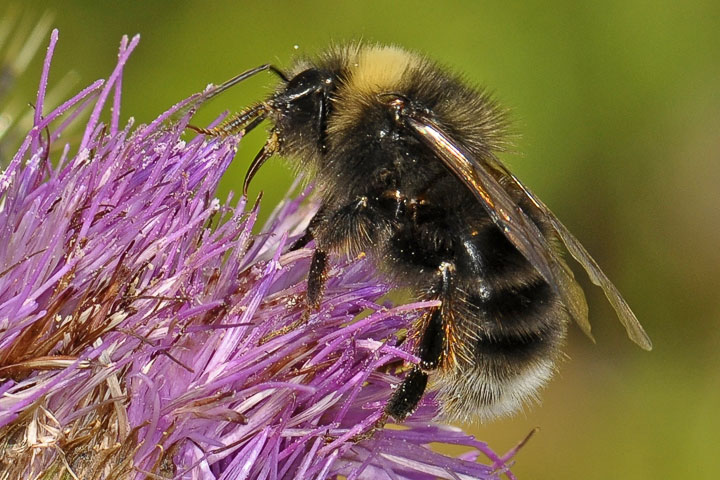 The Bombus occidentalis (western bumble bee) was once common throughout western Canada and U.S. Some reports say it has now all but vanished in southern British Columbia. This male was seen along the West Arm of Kootenay Lake in 2009. ID by RWT
The Bombus occidentalis (western bumble bee) was once common throughout western Canada and U.S. Some reports say it has now all but vanished in southern British Columbia. This male was seen along the West Arm of Kootenay Lake in 2009. ID by RWT
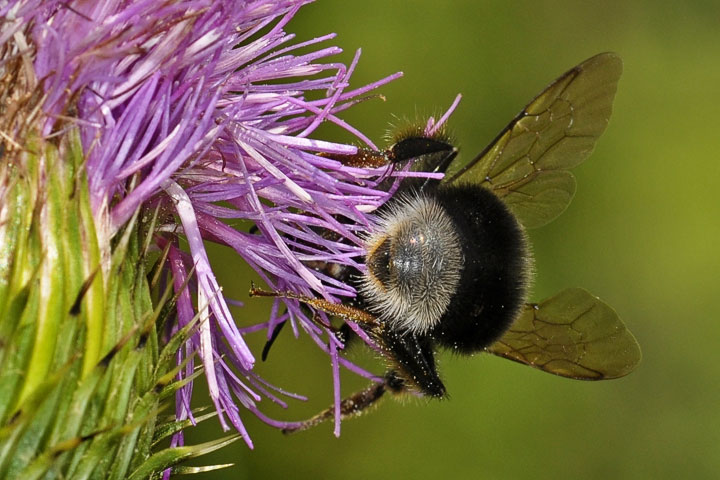 A distinguishing feature of the Bombus occidentalis (western bumble bee) is its white–tipped abdomen.
A distinguishing feature of the Bombus occidentalis (western bumble bee) is its white–tipped abdomen.
ID by RWT
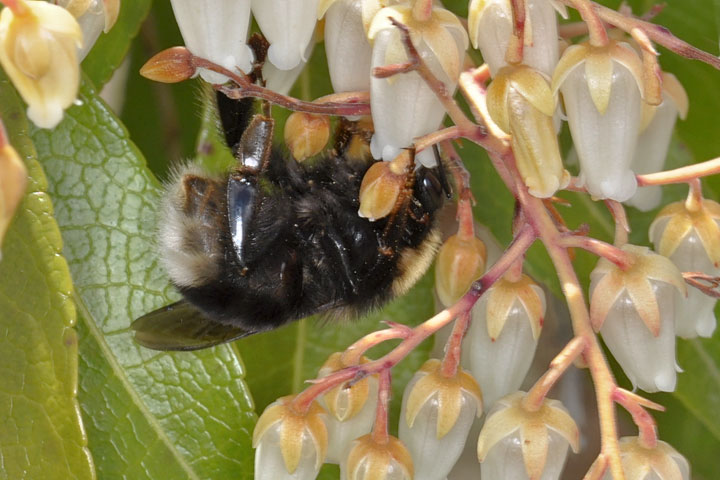 It is mid April and this Western bumble bee is almost certainly a Queen. It is visiting some Pieres japonica.
It is mid April and this Western bumble bee is almost certainly a Queen. It is visiting some Pieres japonica.
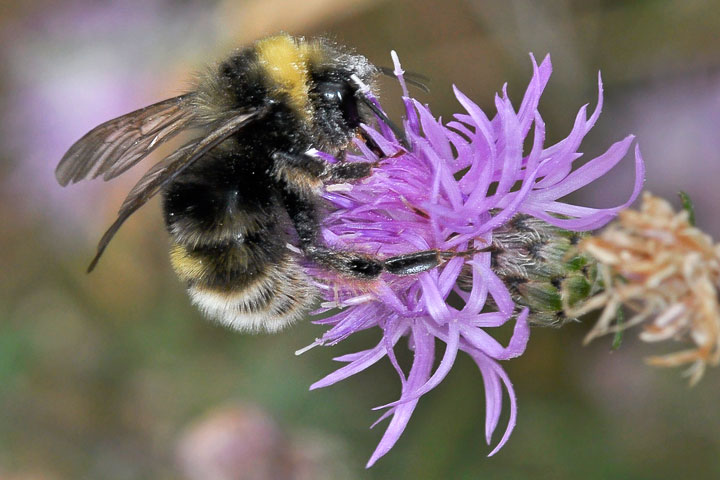 This is one of perhaps a half–dozen western bumble bees that spent some time visiting spotted knapweed. The irony is that these endangered bees had seemingly built an interdependence with a one of the region’s vilified invasive species.In our region, the western bumble bee has two colour variations. Both variations have yellow on the front of the thorax (just behind the head). The difference is the presence or absence of yellow at the back of the thorax (between the wings) and in the middle abdomen (second and third segment) as distinct from it being black there. Both variations are seen in these pictures.
This is one of perhaps a half–dozen western bumble bees that spent some time visiting spotted knapweed. The irony is that these endangered bees had seemingly built an interdependence with a one of the region’s vilified invasive species.In our region, the western bumble bee has two colour variations. Both variations have yellow on the front of the thorax (just behind the head). The difference is the presence or absence of yellow at the back of the thorax (between the wings) and in the middle abdomen (second and third segment) as distinct from it being black there. Both variations are seen in these pictures.
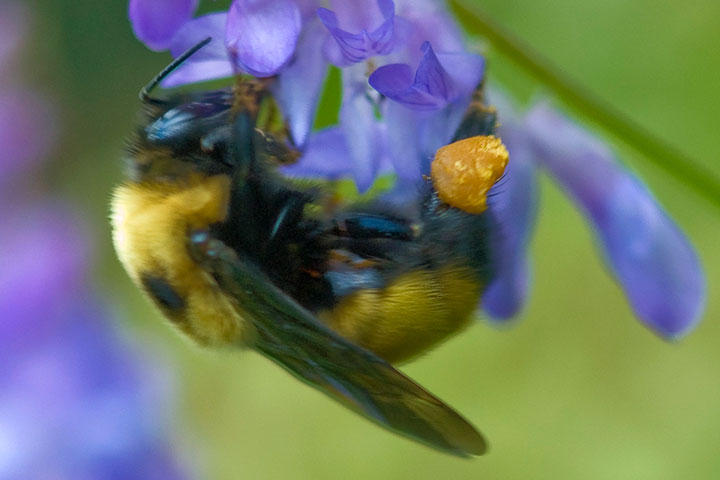 The orange blob on the hind leg of this worker (non–reproductive female), Bombus morissoni is pollen. This portion of the tibia is referred to as the pollen basket and is used to carry pollen from the flowers to the nest. ID by RWT
The orange blob on the hind leg of this worker (non–reproductive female), Bombus morissoni is pollen. This portion of the tibia is referred to as the pollen basket and is used to carry pollen from the flowers to the nest. ID by RWT
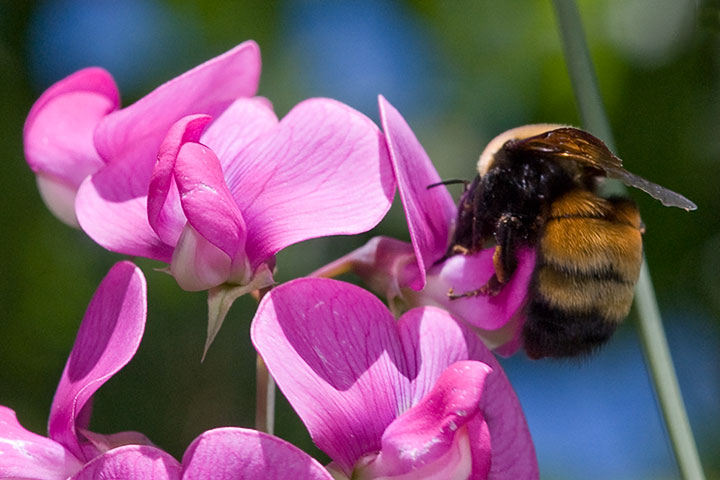 The name, black and gold bumble bee, is more commonly applied to an eastern species, the Bombus auricomus. However, it is virtually indistinguishable from (and often considered conspecific with) the local Bombus nevadensis. So, that name will be applied here to our variant. This worker bee is sipping from a sweet-pea flower. ID by RWT
The name, black and gold bumble bee, is more commonly applied to an eastern species, the Bombus auricomus. However, it is virtually indistinguishable from (and often considered conspecific with) the local Bombus nevadensis. So, that name will be applied here to our variant. This worker bee is sipping from a sweet-pea flower. ID by RWT
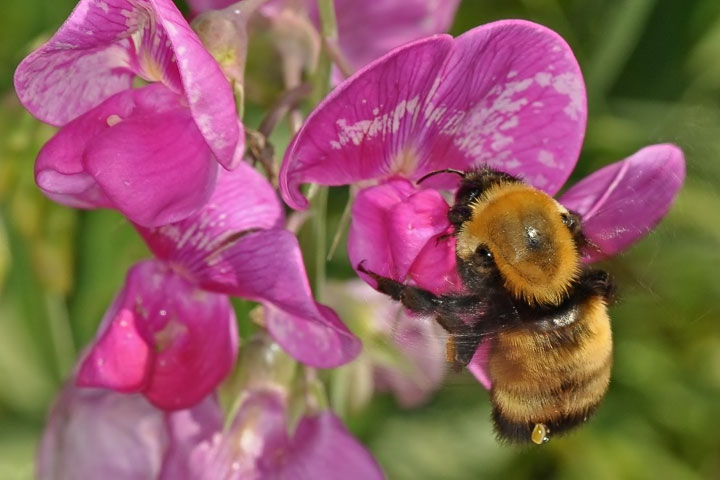 The Bombus nevadensis (black and gold bumble bee) seems to favour pea plants. This worker bee has what appears to be a mite attached to its abdomen. ID by RWT
The Bombus nevadensis (black and gold bumble bee) seems to favour pea plants. This worker bee has what appears to be a mite attached to its abdomen. ID by RWT
 A worker Bombus vagans approaches a tufted vetch with its tongue already extended. ID by RWT
A worker Bombus vagans approaches a tufted vetch with its tongue already extended. ID by RWT
 A Bombus vagans visits some tufted vetch and collects both nectar and pollen from its flowers. This bee has extended its tongue deep into the flower to sip nectar which it then stores in its abdomen for the return trip to the nest. Pollen is transported in pollen sacks on the hind legs; these can be seen as the yellowish blobs on either side of the bee. (Although the tongue is reddish, in this picture it is hidden in a dark sheath). ID by RWT
A Bombus vagans visits some tufted vetch and collects both nectar and pollen from its flowers. This bee has extended its tongue deep into the flower to sip nectar which it then stores in its abdomen for the return trip to the nest. Pollen is transported in pollen sacks on the hind legs; these can be seen as the yellowish blobs on either side of the bee. (Although the tongue is reddish, in this picture it is hidden in a dark sheath). ID by RWT
 This pair of pictures of a Bombus vagans) worker on a St. John’s wort flower shows the banding on thorax and abdomen. ID by RWT
This pair of pictures of a Bombus vagans) worker on a St. John’s wort flower shows the banding on thorax and abdomen. ID by RWT
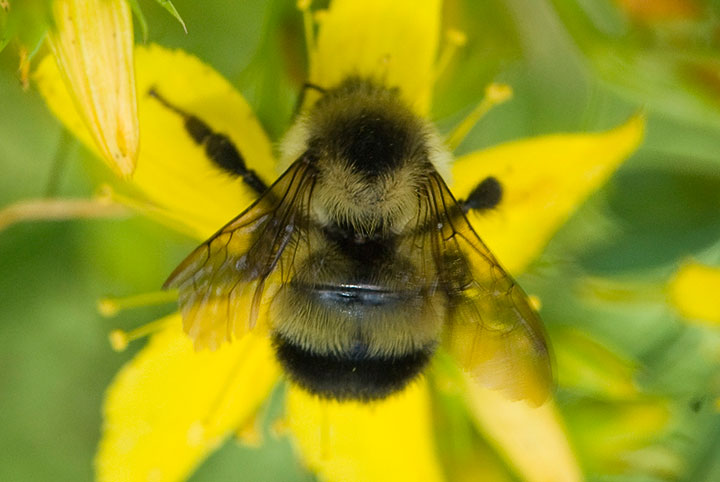 This pair of pictures of a Bombus vagans) worker on a St. John’s wort flower shows the banding on thorax and abdomen. ID by RWT
This pair of pictures of a Bombus vagans) worker on a St. John’s wort flower shows the banding on thorax and abdomen. ID by RWT
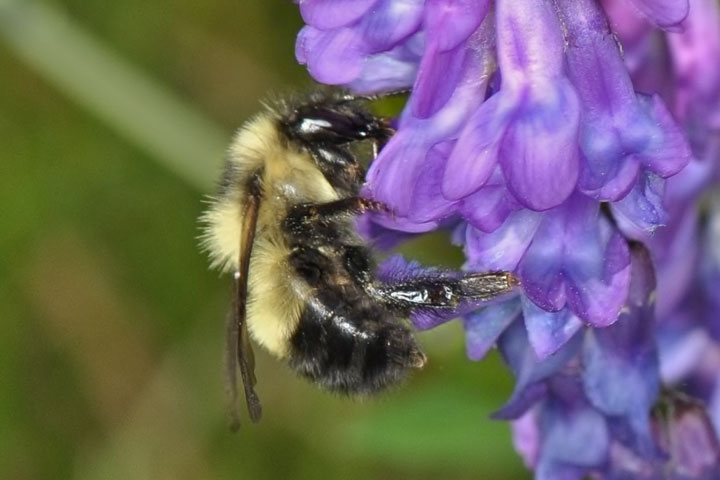 Sometimes a bee gets at the nectar by biting a hole in the side of the flower and extending its tongue through that hole. This is known as nectar robbing because the nectar is taken without the flower receiving compensatory pollination. This appears to be what this Bombus vagans is doing. ID by RWT
Sometimes a bee gets at the nectar by biting a hole in the side of the flower and extending its tongue through that hole. This is known as nectar robbing because the nectar is taken without the flower receiving compensatory pollination. This appears to be what this Bombus vagans is doing. ID by RWT
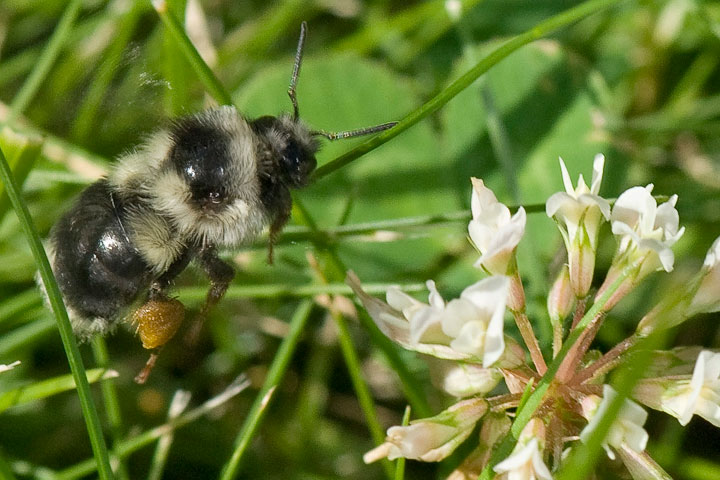 This Bombus bifarius is about to land on clover growing amongst the grass. This species seems to specialize on clover. ID by RWT
This Bombus bifarius is about to land on clover growing amongst the grass. This species seems to specialize on clover. ID by RWT
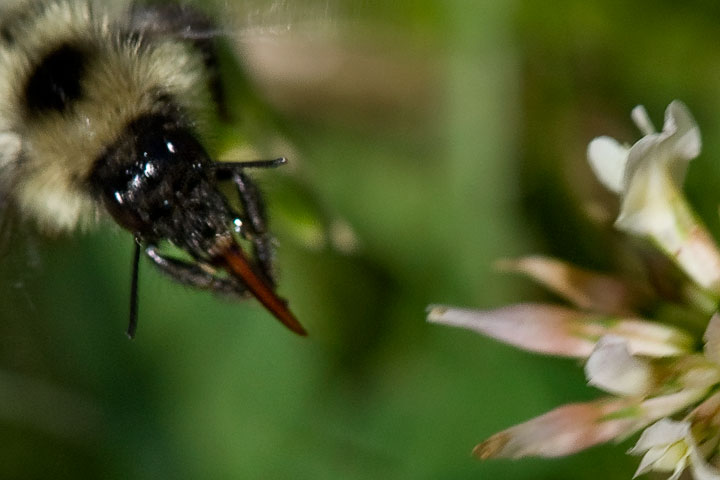 The Bombus vagans has a red tongue which it uses to sip nectar from deep in a flower. When the bumble bee is flying, the tongue is normally folded under its head. Yet, in this view, the tongue is already extended as the bumble bee approaches a white clover. ID by RWT
The Bombus vagans has a red tongue which it uses to sip nectar from deep in a flower. When the bumble bee is flying, the tongue is normally folded under its head. Yet, in this view, the tongue is already extended as the bumble bee approaches a white clover. ID by RWT
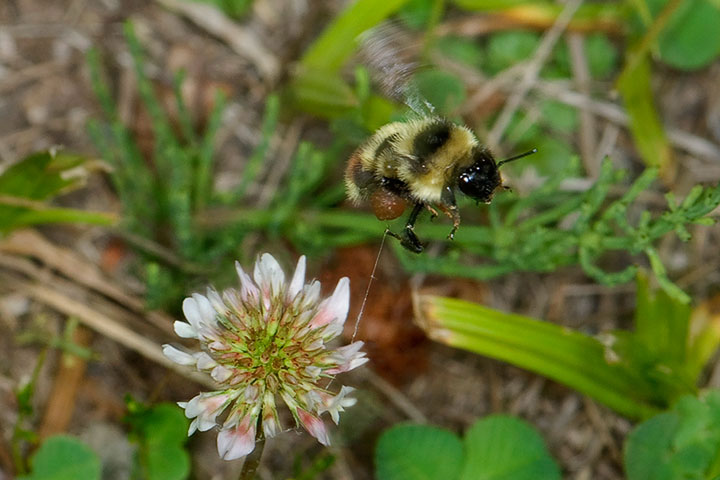 Here is a struggle that this Bombus rufocinctus won. A spider had laid a trap across the flower and the bee’s middle leg became ensnared. As the bee lifted off, its leg was bent back, but the bee pulled free. ID by RWT
Here is a struggle that this Bombus rufocinctus won. A spider had laid a trap across the flower and the bee’s middle leg became ensnared. As the bee lifted off, its leg was bent back, but the bee pulled free. ID by RWT
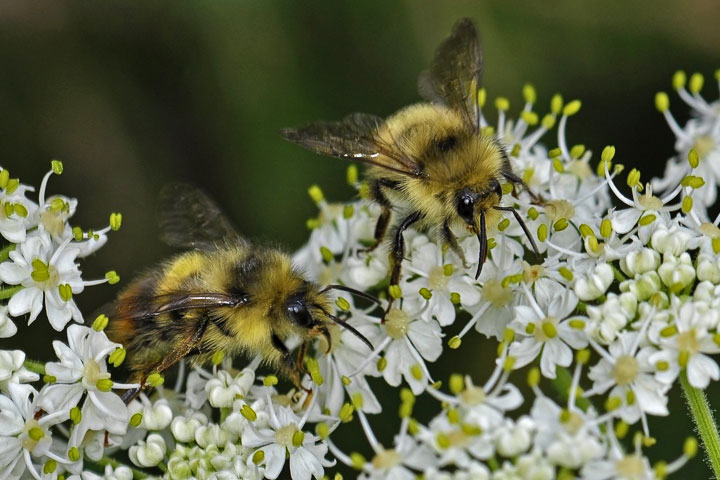 Bombus mixtus brothers visit some cow parsnip in the mountains (at an altitude of about 1500 meters). ID by RWT
Bombus mixtus brothers visit some cow parsnip in the mountains (at an altitude of about 1500 meters). ID by RWT
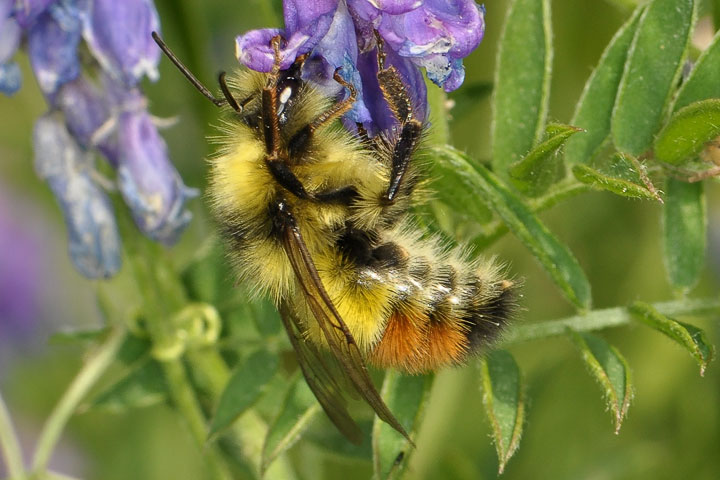 Some mountain species sport reddish bands across the abdomen. This one visiting a tufted vetch is Bombus centralis. ID by RWT
Some mountain species sport reddish bands across the abdomen. This one visiting a tufted vetch is Bombus centralis. ID by RWT
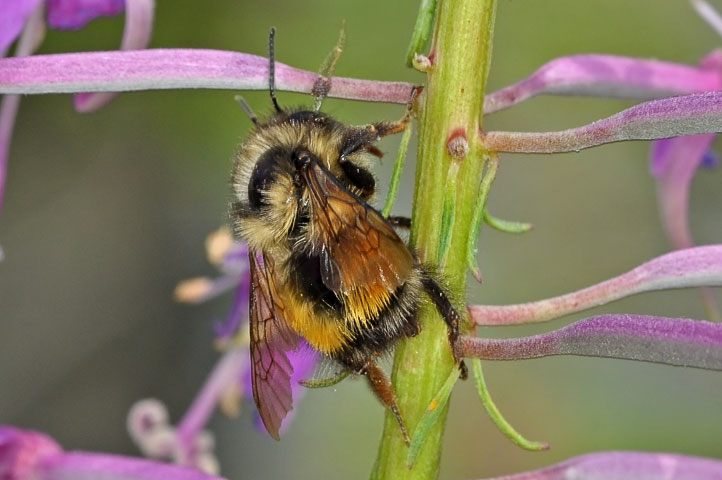 This bumble bee of the mountains visiting the fireweed is a Bombus melanopygus. ID by RWT
This bumble bee of the mountains visiting the fireweed is a Bombus melanopygus. ID by RWT
 The golden body and head of the honey bee easily distinguishes it from the bumble bee. As can be seen by the blob of pollen on the hind leg, the honey bee transports pollen in a manner similar to that of the bumble bee.
The golden body and head of the honey bee easily distinguishes it from the bumble bee. As can be seen by the blob of pollen on the hind leg, the honey bee transports pollen in a manner similar to that of the bumble bee.
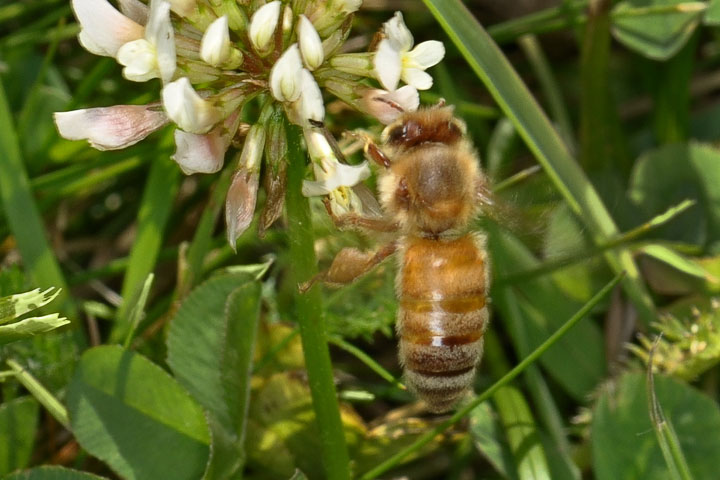 The honey bee (Apis mellifera ligustica) is not a common visitor to my yard. Yet, evidence suggests that there are some feral honey bees in this area, so this visitor may well have come from a natural hive rather than an apiary.
The honey bee (Apis mellifera ligustica) is not a common visitor to my yard. Yet, evidence suggests that there are some feral honey bees in this area, so this visitor may well have come from a natural hive rather than an apiary.
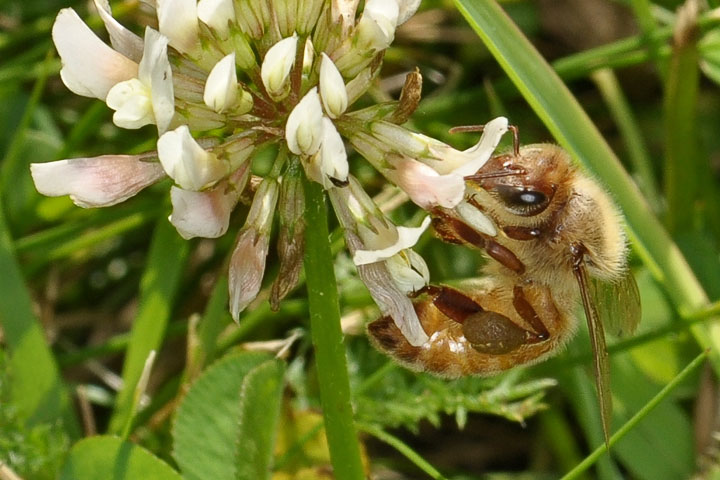 Honey bees haven’t visited often enough for me to know its flower preference, but this one certainly favoured white clover.
Honey bees haven’t visited often enough for me to know its flower preference, but this one certainly favoured white clover.
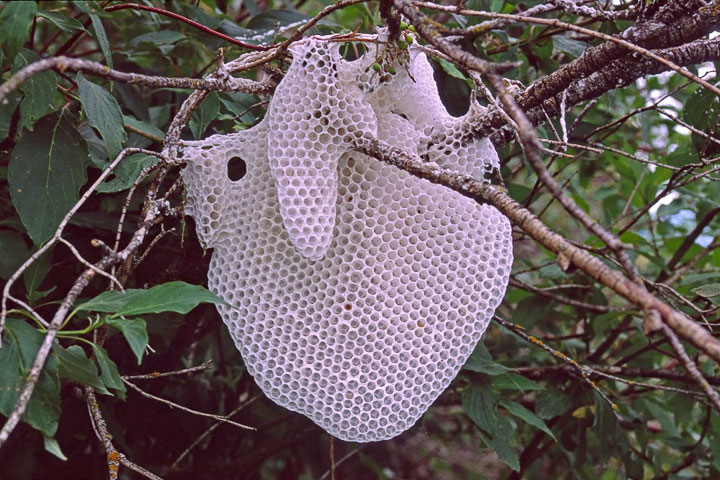 This is a honey bee hive seen at the south end of the Main Lake—clear evidence of locally feral honey bees. Nearby there was a cluster of perhaps a thousand honey bees.
This is a honey bee hive seen at the south end of the Main Lake—clear evidence of locally feral honey bees. Nearby there was a cluster of perhaps a thousand honey bees.  LVD
LVD
![]()